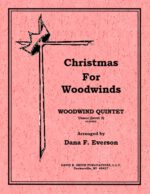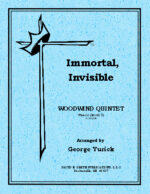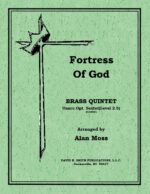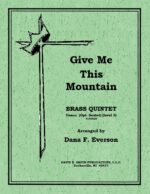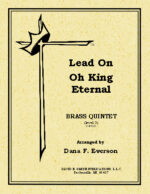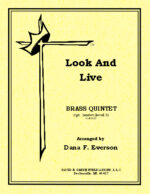| Instrument | |
|---|---|
| Level | 3 |
| Occasion | |
| Writer | |
| Publisher |

Sanctus
$19.95
Based on Schubert’s Sanctus (Holy, Holy, Holy) from his German Mass in F
Related products
-
Christmas for WW
$9.00(std+ opt)(opt quartet) Joy To The World; God Rest Ye Merry Gentlmn; Angels We Have Heard On High; O Little Town Of Bethlehem
-
-
-
-
Give Me This Mountain
$12.00A standard brass quintet with optional trumpet for horn. As one might expect the piece is cheerful from beginning to end. It opens with rhythmic patterns where the first statement of the tune is presented by the trombone. The chorus is harmonically in block format where it comes to an end. NOW, something different the second trumpet and tuba present a simple accompaniment while all the other voice, yes voices, sing the words and melody of the song! A brief conclusion, a modulations and the piece returns to the texture of the earlier statement. The a bit of tongue and check statements and a very conclusive ending.
-
Lead On O King Eternal
$10.00A traditional brass quintet with opt. trumpet for horn and extra baritone for use as a sextet. The introduction uses extraneous material where it leads in the first theme by the trombone until the theme is passed around in fragments until the them is taken over by the trumpets, and the trombones. A modulation takes place where the theme is in the trombones with flourishes in the trumpets. The trumpets now take the theme with flourishes in the middle voices until the piece ends with a declamatory statement.
-
Look And Live
$12.00A traditional brass quintet with opt. trumpet for horn and extra baritone for use as a sextet. The introduction uses extraneous material where it leads in the first theme in the French horn, supplemented by trombone counterlines and trumpet flourishes. Thematic movies are then embellished leading up to a modulation where the tempo slows and a new mood encountered. The first trumpet carries the lead and offset with a horn duet line. Another modulation, an a-tempo with the theme in the low brass and accompaniment lines in the middle brass. This continues until the voices stack up until a boisterous conclusion is achieved.
-
Only A Sinner
$10.00A woodwind quartet for Flute, oboe, and two clarinets with optional parts for flute and alto sax. Plus a set of fifth parts for bassoon or bass clarinet can allow for the piece being a quintet. The first statement is in the clarinets where it leads into a full ensemble passing the lines amongst the parts. A delightful little segue leads to a modulation where the tune is in the lower lines alternated with flourishes in the flutes. This Alternating texture carries on for some time. Then the tempo picks up for a vibrant exclamation where the theme is once again bantered about where it makes one final boast and concludes.

